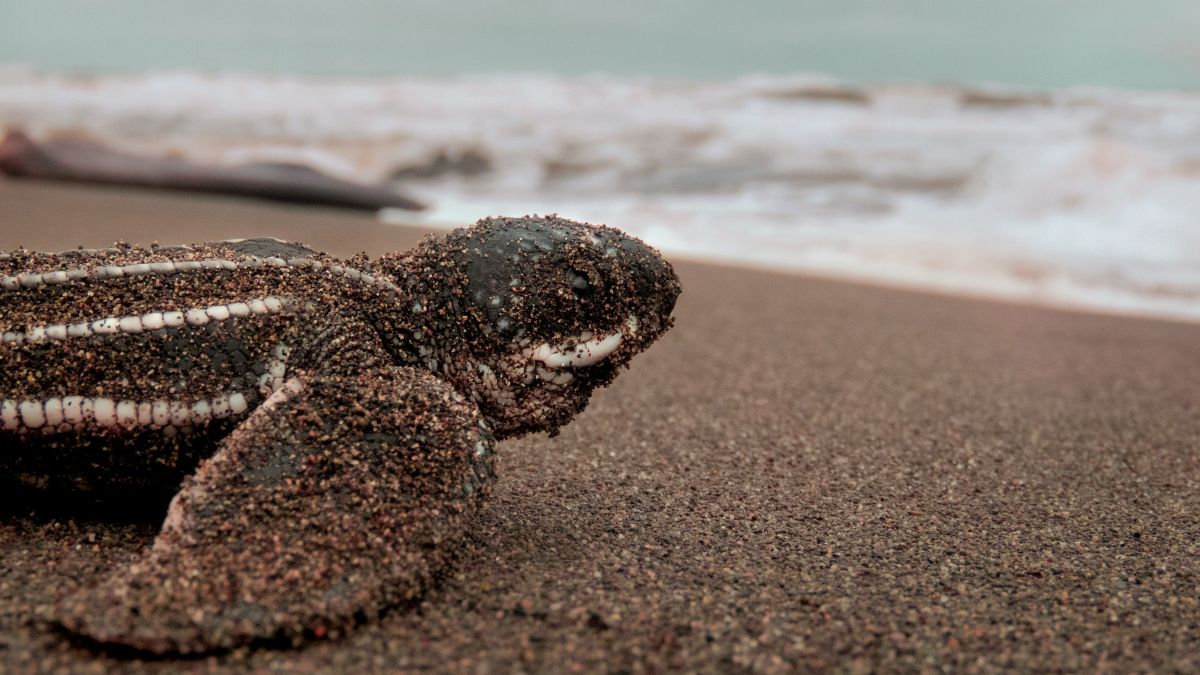Central America Wildlife Guide by Month
8 min readLooking for the best wildlife experiences in Central America Check out our guide to spotting species like sloths, macaws, and sea turtles, broken down by month.
The post A Month-by-Month Guide to Central America Wildlife and the Best Nature Experiences Around the Region appeared first on Central America.

Explore Central America wildlife with our month-by-month guide. Discover the best times and places to spot iconic animals, from humpback whales to jaguars.
There are many reasons to visit Central America. Living here, we know that too well, and we know people travel here for the weather, the beaches, for surfing, fishing, wildlife, nature, birdwatching, and so much more. Especially the wildlife, nature, and birdwatching. After all, there aren’t many other places where it’s so easy to spot sloths, monkeys, macaws, iguanas, crocodiles, and other exciting species pretty much all year round. That’s part of the fun. It’s even possible, if you’re lucky and in the right place, to catch a glimpse of a tapir lumbering through the rainforest. But you have to be lucky.
The bottom line is, nature lovers, you’re in for a treat if you come down to the isthmus for wildlife. Whatever country you’re in, there’s something for you. From snakes and scorpions (yup, they’re here too!) to coatis and cougars, you’re going to find yourself discovering and learning about animals and creepy crawlies up close and personal.
So When’s the Best Time To Visit Central America for Wildlife?
Well, the real answer is anytime. Like we said, many of the most popular species are around all year, and oftentimes all you have to do is hire a guide to show you or simply look up (or down). But there are some months where it’s easier to see some creatures than others. Some months offer more spectacular sightings of certain species than others. In this guide, we take a trip through the calendar year, month-by-month, so you know where the best location to be in is to spot something. It’s important to say that you can certainly see these animals or birds at other times of the year or in other countries – you certainly can and that’s the beauty of this part of the world. All we’re doing is showing you where a great chance of encountering these animals is in the region per given month.
So get your naturalist gear on, charge up your smartphone (you might well need it to send pics and videos in real time back home or to post on Instagram), and stay connected wherever you go with a good eSIM global network, so you never miss a moment in the wild. Let’s get started!
January – Humpback and Blue Whales in Los Cobanos, El Salvador
California humpbacks come down the Pacific coast towards the end of each year, seeking warmer waters from the frigid winter temperatures of offshore Canada and the United States. Call them marine snowbirds. And while you can see these humpbacks around this time of year anywhere between Mexico and Ecuador, there’s a reason why we call out El Salvador as the best place for January whale watching. That reason is the possibility of also seeing blue whales – the largest animals on earth – off the coast of Los Cobanos.
February – Scarlet Macaws in Red Bank, Belize
Like most of the wildlife we talk about here, you can see scarlet macaws elsewhere in Central America, particularly in Costa Rica, Honduras, and Panama. But the annual arrival of hundreds of these birds to the tiny Mayan community of Red Bank, near Placencia in southern Belize, causes somewhat of a stir each year among birdwatchers. Large flocks gather here between December and March, migrating from all over, to eat the fruit of local “pole wood” trees that ripen around now. As we say, you can find scarlet macaws elsewhere but perhaps not as many visible in one place as here.
March – Quetzal Nesting Time in Costa Rica and Guatemala
Staying with our feathered friends, if you seek to see the elusive resplendent quetzal, one of Central America’s (and the world’s) most beautiful birds, then this is the time of year to do it. Sacred to the Maya and surrounded by local mythology, quetzals live in highland cloud forest areas between southern Mexico and western Panama, and they’re now pretty rare. Birdwatchers come from around the world to find quetzals and many leave disappointed. That said, February to June are the best months to catch a glimpse, as this is their breeding period and they’re out and about more. Head to Monteverde or San Gerardo de Dota in Costa Rica or the Refugio del Quetzal near San Marcos in Guatemala (where quetzals are both the national bird and name of the currency) for your best chance.
April – Leatherback Turtles in Tortuguero, Costa Rica
Turtle nesting is a huge reason why nature lovers come to Central America, and many of them target the aptly-named Tortuguero National Park on the northern Caribbean coast of Costa Rica. This remote park is one of the best places on the planet to view all manner of nesting sea turtles, but travelers here between March and May can experience massive (the largest sea turtles on earth) leatherbacks hauling themselves up the beach to lay their eggs. You’ll need to take a guided tour for this, but it’s absolutely worth it.
May – Whale Sharks off Gladden Spit, Placencia, Belize
The Caribbean waters of southern Belize between March and June receive an amazing visitor each year. Roughly from full moon in March to full moon in June, if you’re willing to don diving gear or even a snorkel, you can get wet and swim with whale sharks, the world’s biggest fish. They come to an atoll of the Belize Barrier Reef called Gladden Spit, some 26 miles off the coast to feed on the spawn of dog snappers. It’s a cliché that whale sharks are gentle giants but they truly are, and swimming with a fish the size of a bus is something you’ll never forget.
June – Jaguars at the Cockscomb Basin Wildlife Sanctuary, Belize
Jaguars are the holy grail of wildlife spotting in Central America. The largest big cats on earth (yes, alongside the largest turtles, fish, and whales, we also have the largest cats) aren’t easy to see, ever. They’re in remote areas of every country in the region, but again, so difficult to actually spot outside of footprints. That said, during the rainier months of June and July in Belize, if you visit the world’s first and only dedicated jaguar preserve – Cockscomb Basin Wildlife Sanctuary – in southern Belize and take a guided nocturnal tour, you might get lucky. You have more chance of getting lucky here than anywhere else, anyway.
July – Bottlenose Dolphins in Bocas del Toro, Panama
Dolphins are pretty common on both Pacific and Caribbean coasts of Costa Rica year-round, and that includes the Bocas del Toro archipelago in Panama. But in June and July, in Dolphin Bay on the hidden side of Isla Cristobal, the water is super calm and dolphins come here to get away from rougher seas elsewhere and to feed on the crustaceans and small fish they find among the mangroves. It’s super easy to see whole pods of dolphins here, including mothers and calves. If you’re in Bocas at this time of year, arrange a boat tour to Dolphin Bay.
August – Humpback Whales in Uvita, Costa Rica
If you missed out on El Salvador whale watching in January, Costa Rica between July and October is also perfect. This time of year sees southern humpbacks along the Pacific side of Central America, up from Antarctic waters to breed and feed. Basically northern humpbacks head south during the northern winter and southern humpbacks head north in the southern winter and Central America is where they end up. Anyway, Costa Rica’s Central and Southern Pacific, especially the Uvita area, is top-drawer whale watching in August.
September – Olive Ridley Arribadas in Costa Rica and Nicaragua
Arribada means “arrival” and describes the mass turtle-nesting phenomenon that occurs when thousands of turtles at once arrive on a specific beach to lay their eggs. What the aforementioned leatherback turtles have in size, Olive Ridley turtles have in numbers. Most of the time, Olive Ridley come ashore alone, but arribadas bring them all at once. No one really knows what causes an arribada, but they generally happen the week before a new moon. If you get to experience one you’ll remember it forever. Go to either Playa Ostional near Nosara in Costa Rica or Playa La Flor near San Juan del Sur, Nicaragua and you might catch a break.
October – Sloths in Cahuita, Costa Rica
Sloths are, as mentioned earlier, pretty common around the region and not too hard to see if you know where to look. The thing is that October is the wettest month of the year and many national parks are closed due to bad weather and lack of visitors. It’s a time to close up and relax. But the southern Caribbean coast of Costa Rica actually has its best weather, and if you explore Cahuita National Park, you have a great chance of seeing sloths and a bunch of other creatures in the sunshine while everyone else is stuck inside.
November – Jaribu Storks at the Crooked Tree Wildlife Sanctuary, Belize
Another one for the birdwatching community here. November is actually one of the best months for birdwatching across Central America, as we start to see migratory birds come down from the north or pass through on their way somewhere to somewhere else. Lots of birds in Central America at this time of year. But the Crooked Tree Wildlife Sanctuary in northern Belize features a bunch of water birds, including the jabiru stork. These are the tallest birds in Central and South America and they arrive at Crooked Tree in November to nest. An unmissable treat for serious birdwatchers.
December – Turtle Releases at Monterrico, Guatemala
We’ve covered turtles a lot in this guide, and for good reason. If you’re a nature lover interested in sea turtles, this is the best region in the world to visit. But we’ve covered the nesting more than anything, where mama turtles arrive from the ocean to lay their eggs. The beach community of Monterrico, on Guatemala’s Pacific coast, is perfect in December for releasing newborn turtles into the ocean to start their lives. What happens is that green turtles, leatherback turtles, and Olive Ridleys arrive to lay their eggs back in October and now they’re ready to hatch. Locals and volunteer orgs protect the eggs and release them on certain dates. December and January are the best months for this. Another great family experience to enjoy.
Enjoy Our Central America Wildlife Year Round
That wraps up our month-by-month guide to Central America wildlife and where to spot it. Again, we need to stress that many of the above nature experiences are possible to enjoy at other times of year and in other places around the region. But we hope it gives you a good enough idea of what to see and where/when to go for the best chance of seeing it. Have a great time!
James Dyde is the editor of centralamerica.com. He lives in Escazu, Costa Rica.



